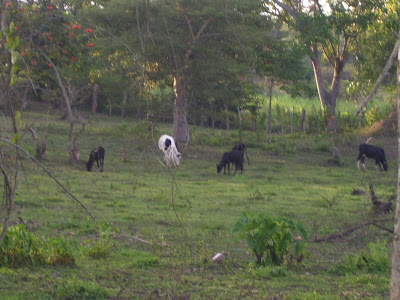After only one day in Kamuli Lindsay and I hopped on the back of boda bodas (motorcycles). We were headed to the home of Sharifa, one of the 52 Kids. Upon arrival we were greeted warmly by her family, each person kneeling down and holding our hands. The women greeted us with the traditional welcoming shriek and giant loving embraces. Kaiso, one of the employees of 52 Kids here in Kamuli stuck around with us for a while and helped translate so we could get to know the family better. Before we knew it the sun had set, and we were without light. Luckily, Lindsay and I had brought headlamps which helped profusely as we played the Ugandan version of "UNO" with Sharifa's uncle, Daniel. At around 8:30 PM we were served a delicious snack of roasted groundnuts, which taste a lot like peanuts, and fresh tea. As we waited for the actual meal Lindsay and I played tons of games with Sharifa, her siblings and cousins, as well as two of the other 52 Kids, Gerald and Jesca. We played thumb wars, ring around the rosie, the slap game, and even the macarana. In turn they taught us a few Ugandan games, and soon we were all having the greatest time. For dinner we were served a feast. It included mashed plantains, baked casava (which is a type of flour that they use here), greens, beans, and chicken. The women had been slaving over the meal for hours, it was incredibly kind and generous of them. After eating it was almost 11:00 PM, so we decided to head into bed. Sharifa's family, along with the help of Josefine, had set up a beautiful looking bed for us to sleep in. We felt incredibly lucky to be able to experience such a wonderful family. In the morning we woke up so that we could walk around the village and meet other neighbors and friends of the family. Each time we were greeted warmly, and we even learned how to greet the proper way for a woman, kneeling down and saying "wasazo tia nyabo/sevo" (definitely not the right spelling!) We had such a great time talking to each family, and every time we were given a parting gift such as fruits, eggs, or groundnuts. Finally, it was time to leave. It was sad to say goodbye and it was hard to describe how thankful we were for their generosity and kindness. A few days later we returned to Sharifa's home to bring a thank you gift of sugar and a pan, the family again was so excited to see us, and we hope to visit them one more time before our departure!
Continue Reading...





















 After a morning of work we sat on the front porch reading books. We read a book Ester brought called
After a morning of work we sat on the front porch reading books. We read a book Ester brought called 

























